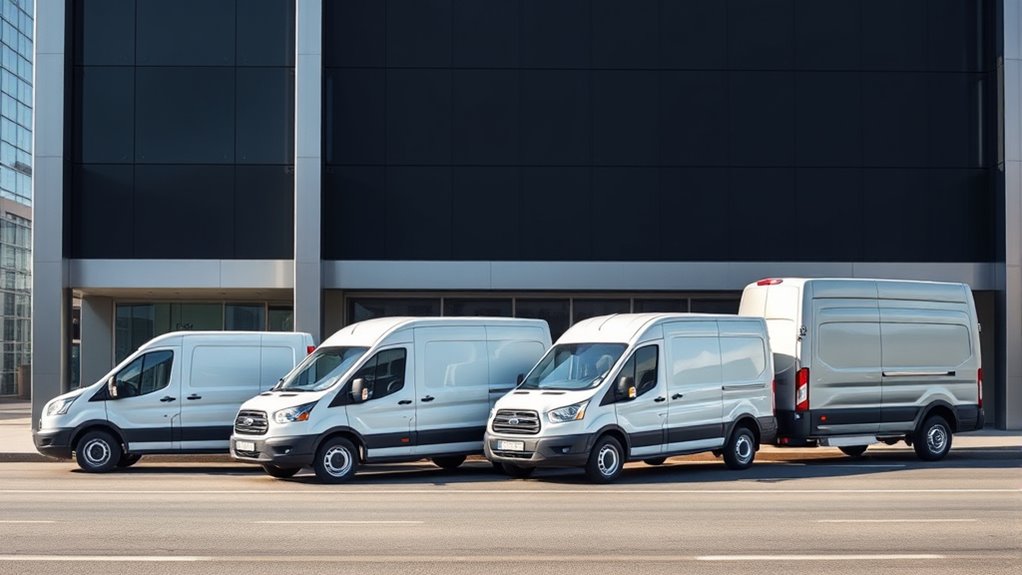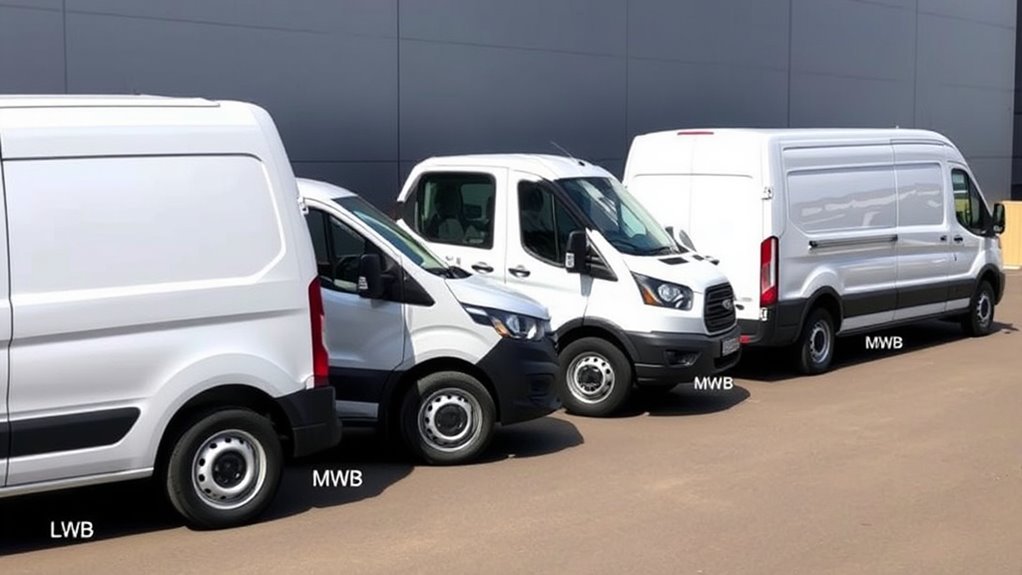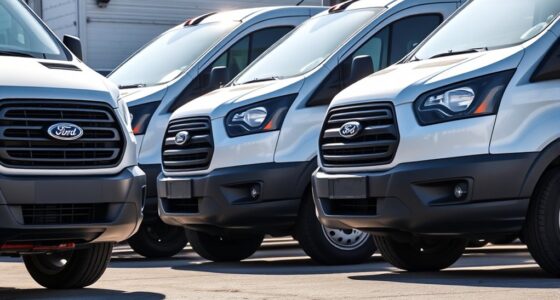Understanding wheelbase and length codes like SWB, MWB, LWB, and Extended helps you choose the right vehicle for your needs. SWB has the shortest wheelbase, ideal for urban driving and tight spaces. MWB offers a balance of cargo space and maneuverability. LWB provides more capacity and stability, great for longer trips. Extended versions increase cargo, but reduce agility. If you want to know more about these options, you’ll find useful details just ahead.
Key Takeaways
- SWB, MWB, LWB, and Extended refer to different vehicle wheelbase lengths, affecting size, capacity, and maneuverability.
- SWB typically ranges from 2.4 to 2.9 meters, ideal for urban environments.
- MWB spans approximately 3.3 to 3.9 meters, balancing cargo space and handling.
- LWB and Extended wheelbases offer increased cargo capacity and stability but may reduce maneuverability.
- Length codes correlate with overall vehicle length, influencing parking, route planning, and regulatory compliance.
Understanding Short Wheelbase (SWB) Vans

Short wheelbase (SWB) vans are designed to be more compact and maneuverable than their medium and long wheelbase counterparts. The wheelbase, the distance between the front and rear wheels, is shorter in SWB models, typically measuring between 2.4 and 2.9 meters. These vans usually span about 5.5 to 6 meters in length, making them easier to handle in tight spaces. While their cargo capacity is smaller—generally under 300 cubic feet—this trade-off enhances agility. SWB vans come with various roof heights, from standard to extra high, allowing some flexibility in cargo stacking. They are ideal for urban environments, offering a smaller footprint, easier parking, and tighter turning radii, perfect for *orchestrating* narrow streets and crowded city centers. Incorporating good lighting can further enhance visibility in tight or congested areas, improving safety and efficiency. Additionally, the wheelbase length significantly influences the vehicle’s overall handling and stability, especially when navigating challenging city routes.
Exploring Medium Wheelbase (MWB) Options

Medium Wheelbase (MWB) vans occupy a versatile middle ground between compact and long-wheelbase models, offering a balance of cargo space and maneuverability. Typically, MWB wheelbases measure between 3,300 mm and 3,924 mm, making them suitable for urban delivery and daily operations. For example, the Ford Transit MWB has a 148-inch (3,752 mm) wheelbase and an overall length of nearly 6 meters. These vans provide internal cargo lengths of around 3,200 to 3,650 mm, with cargo volumes reaching up to 11 m³, especially with higher roof options. Their moderate length and width facilitate tighter turns and easier handling, making them ideal for city environments. Powertrain options often include 3.5L to 3.7L engines, balancing efficiency and payload capacity. MWB vans are popular across industries that need flexible cargo space without sacrificing maneuverability. Additionally,, their size allows for better access to tight parking spaces and urban job sites. Implementing a mindful approach to driving can maximize efficiency and safety in crowded settings.
Characteristics of Long Wheelbase (LWB) Vehicles

Long wheelbase (LWB) vehicles feature a considerably extended distance between the front and rear axles, typically ranging from 3.2 meters to over 4.5 meters. This longer wheelbase results in overall lengths from about 5.8 to 7.0 meters, providing markedly more cargo space and improved payload capacity. For example, the Ford Transit LWB and Mercedes Sprinter LWB are popular for commercial use, offering ample storage. The extended chassis offers smoother, more stable rides at high speeds, thanks to better weight distribution. Additionally, the wheel size plays a role in handling and ride quality for these vehicles, and selecting appropriate suspension systems can further enhance comfort and safety. Moreover, the handling characteristics of LWB vehicles are influenced by their extended length, often making them less agile in tight spaces.
The Role of Extended Wheelbase (XLWB/ELWB) in Commercial Usage

Extended wheelbase (XLWB/ELWB) vehicles play a vital role in commercial operations by greatly increasing cargo capacity and supporting heavier loads. Their longer chassis allows you to carry larger tools, equipment, or bulky cargo, reducing the number of trips needed and boosting efficiency. The added length supports higher payloads without compromising stability, making them ideal for trades and delivery services. Many configurations include interior fittings like shelves or storage, enhancing utility for mobile workshops or service vehicles. Additionally, the longer wheelbase can improve vehicle stability during transit, which is crucial for safety and performance. The increased length can hinder maneuverability, complicating navigation in tight urban areas and limiting parking options. Operating XLWB vehicles requires skill and careful route planning to avoid restrictions. Despite some challenges, they deliver significant benefits in cargo capacity, operational efficiency, and safety at highway speeds. Longer wheelbases improve the distribution of weight across the vehicle, which can enhance overall safety and performance during transit. Furthermore, understanding vehicle dimensions is essential for compliance with transportation regulations and ensuring accessibility in various operational environments. Proper vehicle weight distribution also plays a key role in maintaining handling and braking performance, especially when carrying heavy loads.
Frequently Asked Questions
How Do Wheelbase Variations Affect Vehicle Stability and Safety?
You’ll find that longer wheelbases improve your vehicle’s stability and safety by distributing weight evenly, reducing pitch during turns, and providing a smoother ride. They also enhance high-speed grip and decrease rollover risk. However, shorter wheelbases make maneuvering easier in tight spaces but can compromise stability at higher speeds. Balancing wheelbase length depends on your driving needs, prioritizing either agility or safety and stability.
What Are the Maintenance Differences Among SWB, MWB, LWB, and XLWB Vans?
You’ll find that as the wheelbase increases, maintenance complexity rises markedly—by up to 40% for XLWB compared to SWB. With SWB vans, you enjoy easier access, simpler systems, and lower costs. Moving to MWB and LWB, expect longer service times, more parts, and higher repair costs due to extended components and increased wear. XLWB demands the most effort, often requiring specialized skills and equipment for repairs and inspections.
How Does Wheelbase Impact Fuel Efficiency Across Different Van Sizes?
You’ll notice that longer wheelbases usually mean higher fuel consumption because of increased weight and aerodynamic drag. Shorter wheelbase vans are more fuel-efficient, especially in city driving, due to their lighter weight and less wind resistance. As the van size grows, fuel efficiency tends to decrease, making longer wheelbase models less economical for fuel. Choosing the right wheelbase depends on your balance of cargo needs and fuel savings.
Are There Specific Models Best Suited for Conversions Based on Wheelbase?
Choosing the right van for your conversion is like finding a tailor-made suit—you want it to fit perfectly. If maneuverability matters most, go for a smaller model like the SWB or MWB. For maximum interior space and comfort, LWB or Extended versions are ideal. Mercedes Sprinter, Ford Transit, and Ram Promaster stand out, offering versatile wheelbase options that suit various needs, whether urban adventures or full-time living.
How Do Wheelbase Options Influence Vehicle Resale Value?
Your choice of wheelbase options directly impacts your vehicle’s resale value. Longer wheelbases often appeal to buyers seeking more space and comfort, boosting resale prices, especially in SUVs and trucks. Shorter wheelbases may attract urban drivers valuing maneuverability, which can also be beneficial. Ultimately, selecting the right wheelbase for your vehicle type and market demand helps retain value, so consider what buyers in your segment prefer.
Conclusion
So, here’s a thought: could the choice of wheelbase size actually influence not just cargo capacity but also your vehicle’s overall safety and handling? While shorter wheelbases are nimble, longer ones offer stability. It’s not just theory—research suggests that the right wheelbase can make a real difference in your driving experience. Next time you pick a van, consider how your choice might impact more than just space; it could shape your entire journey.









